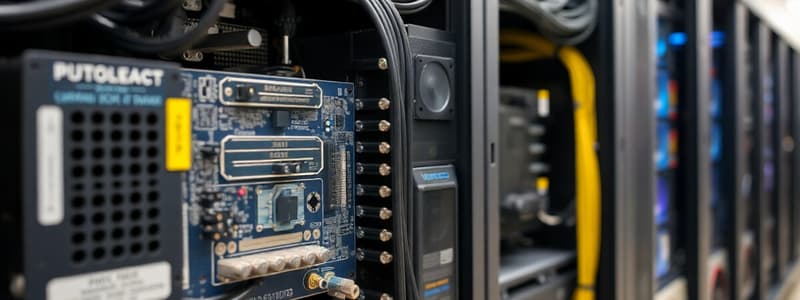Podcast
Questions and Answers
What is the primary function of software in a computer system?
What is the primary function of software in a computer system?
- To create documentation for users
- To improve hardware performance
- To command hardware to perform tasks (correct)
- To enhance network connectivity
Which type of computer is categorized as a microcomputer?
Which type of computer is categorized as a microcomputer?
- Supercomputers
- Midrange computers
- Mainframe computers
- Wearable computers (correct)
What should be a major consideration when purchasing a personal computer?
What should be a major consideration when purchasing a personal computer?
- The brand reputation of the hardware
- The color and design of the computer
- The availability of discount offers
- The anticipated lifespan and needed service (correct)
Which of the following is NOT a strategic hardware issue for gaining competitive advantage?
Which of the following is NOT a strategic hardware issue for gaining competitive advantage?
What does the term 'microcomputer' encompass?
What does the term 'microcomputer' encompass?
What is the role of the Control Unit in a CPU?
What is the role of the Control Unit in a CPU?
Which type of memory is NOT considered primary storage?
Which type of memory is NOT considered primary storage?
What is the correct hierarchy for measuring digital storage from smallest to largest?
What is the correct hierarchy for measuring digital storage from smallest to largest?
Which of the following is NOT a type of secondary storage?
Which of the following is NOT a type of secondary storage?
What is the approximate size of a Petabyte in relation to Gigabytes?
What is the approximate size of a Petabyte in relation to Gigabytes?
Which of the following is NOT categorized as a human data-entry device?
Which of the following is NOT categorized as a human data-entry device?
What type of device is a Microsoft Kinect primarily considered?
What type of device is a Microsoft Kinect primarily considered?
Which of the following statements about the CPU is true?
Which of the following statements about the CPU is true?
Which output device is suitable for high-quality color printing?
Which output device is suitable for high-quality color printing?
Which of the following is NOT a function of input devices?
Which of the following is NOT a function of input devices?
Which input device is specifically designed for capturing hand-drawn graphics?
Which input device is specifically designed for capturing hand-drawn graphics?
What are the major components of a computer system?
What are the major components of a computer system?
What type of monitors uses Organic Light-Emitting Diodes (OLED)?
What type of monitors uses Organic Light-Emitting Diodes (OLED)?
How does primary storage differ from secondary storage?
How does primary storage differ from secondary storage?
Which of the following devices can be used for both data input and output?
Which of the following devices can be used for both data input and output?
Which component is not considered a part of IT infrastructure?
Which component is not considered a part of IT infrastructure?
Which technology primarily organizes, manages, and processes business data?
Which technology primarily organizes, manages, and processes business data?
What role does the Central Processing Unit perform in a computer?
What role does the Central Processing Unit perform in a computer?
Which of the following pairs distinguishes input from output technologies?
Which of the following pairs distinguishes input from output technologies?
What is the primary difference between microprocessor component designs and performance?
What is the primary difference between microprocessor component designs and performance?
Which of the following statements about computer hierarchy is correct?
Which of the following statements about computer hierarchy is correct?
Flashcards
Hardware
Hardware
The physical components of a computer system, like the CPU, RAM, hard drive, keyboard, monitor and printer.
Central Processing Unit (CPU)
Central Processing Unit (CPU)
The core processing unit of a computer, responsible for executing instructions and performing calculations.
Primary Storage (RAM)
Primary Storage (RAM)
The temporary storage space where a computer holds data and instructions currently being used.
Secondary Storage
Secondary Storage
Signup and view all the flashcards
Input Technologies
Input Technologies
Signup and view all the flashcards
Output Technologies
Output Technologies
Signup and view all the flashcards
IT Infrastructure
IT Infrastructure
Signup and view all the flashcards
Data Management Technology
Data Management Technology
Signup and view all the flashcards
Software
Software
Signup and view all the flashcards
Microcomputer Software
Microcomputer Software
Signup and view all the flashcards
Supercomputer
Supercomputer
Signup and view all the flashcards
Mainframe Computer
Mainframe Computer
Signup and view all the flashcards
Midrange Computer
Midrange Computer
Signup and view all the flashcards
Input Device
Input Device
Signup and view all the flashcards
Control Unit
Control Unit
Signup and view all the flashcards
Arithmetic-Logic Unit (ALU)
Arithmetic-Logic Unit (ALU)
Signup and view all the flashcards
Output Device
Output Device
Signup and view all the flashcards
CRT Monitor
CRT Monitor
Signup and view all the flashcards
LCD Monitor
LCD Monitor
Signup and view all the flashcards
Gesture-Based Input
Gesture-Based Input
Signup and view all the flashcards
What does ALU stand for?
What does ALU stand for?
Signup and view all the flashcards
What is cache memory?
What is cache memory?
Signup and view all the flashcards
What are registers in a CPU?
What are registers in a CPU?
Signup and view all the flashcards
What is memory capacity?
What is memory capacity?
Signup and view all the flashcards
What is primary storage?
What is primary storage?
Signup and view all the flashcards
Study Notes
Chapter 0: Hardware
- Hardware encompasses all physical components of a computer system
- It includes the CPU, primary storage, secondary storage, input technologies, output technologies, and communication technologies
- Hardware and software are required for a computer to function
- Hardware includes all physical components, both inside the main computer case, and external devices
- Software is the set of instructions or programs that tell the hardware what to do
- IT infrastructure is the set of physical devices and software necessary to operate enterprise IT systems, supporting various business information systems
- IT infrastructure's core components include computer hardware, computer software, data management technology, networking and telecommunications technology, and technology services
- A firm's IT infrastructure encompasses hardware, software, data management, networking, and technology services
Hardware Components
- Central Processing Unit (CPU)
- Primary Storage (RAM, ROM, Cache, Register Memory)
- Secondary Storage (Magnetic Tape, Magnetic Discs, Solid State Drives (SSD), Optical Storage Devices, Flash Memory)
- Input Technologies (Keyboards, Mice, Touchscreens, Styluses, Scanners, Cameras, etc.)
- Output Technologies (Monitors, Printers, Voice Output devices)
- Communication Technologies (Network Cards, Modems etc.)
Strategic Hardware Issues
- Rapid price reductions and performance advancements in hardware necessitate strategic adaptation
- Businesses need to consider new hardware infrastructures and their implications for work styles
- The use of mobile computers and advanced communication technologies needs assessment for employee and organizational benefit.
Computer Hierarchy
- The computer hierarchy arranges computers based on their power and roles
- Examples of categories include supercomputers, mainframe computers, midrange computers, microcomputers, and wearable computers
Microcomputers
- Common kinds of microcomputers include Desktops, Thin-Client/Fat-Client Systems, Laptops, Netbooks, and Tablet Computers
It's Personal: Purchasing a Computer
- Considerations for buying a personal computer include intended use, usage location, and service requirements
Input and Output Technologies
- Multimedia technology, input devices, and output devices are essential components for computer interaction
Input Devices
- Human Data-Entry devices (Keyboard, Mouse, Trackballs, Pointing Sticks, Touchpads, Graphics Tablets, etc.)
- Gesture-Based Input devices (Wii, Microsoft Kinect, Leap Motion, etc.)
- Source-Data Automation Input devices (ATM, Magnetic Strip Reader, POS Terminals, Barcode Scanners, Optical Mark Readers, Magnetic Ink Character Reader, Optical Character Recognition, Sensors, Cameras, Radio Frequency Identification (RFID)
Output Devices
- Monitors (Cathode Ray Tubes (CRT), Liquid Crystal Displays (LCD), Flexible Displays, Organic Light-Emitting Diodes (OLED), Retinal Scanning Displays)
- Printers (Laser Printers, Inkjet Printers, Thermal Printers, Plotters)
- Voice Output devices (Electronic Book Readers, Pocket Projectors, etc.)
The Central Processing Unit (CPU)
- The CPU is a microprocessor with a control unit, arithmetic-logic unit (ALU), and registers
- The CPU fetches, decodes, and executes instructions from programs stored in memory
- Data is processed and stored in the CPU via the ALU
- Primary storage for data and instructions is RAM (random access memory)
Computer Memory
- Memory capacity is measured in units like bits, bytes, kilobytes, megabytes, gigabytes, terabytes, petabytes, exabytes, and zettabytes
- Primary memory (RAM, ROM, Cache, Registers) is crucial for immediate CPU processing, while secondary storage (HDDs, SSDs, optical drives) stores data for long-term use
PC Components/Cost Compared
- The data shows the trend of increasing RAM and hard drive capacity, along with decreasing CPU cost over time.
Studying That Suits You
Use AI to generate personalized quizzes and flashcards to suit your learning preferences.





